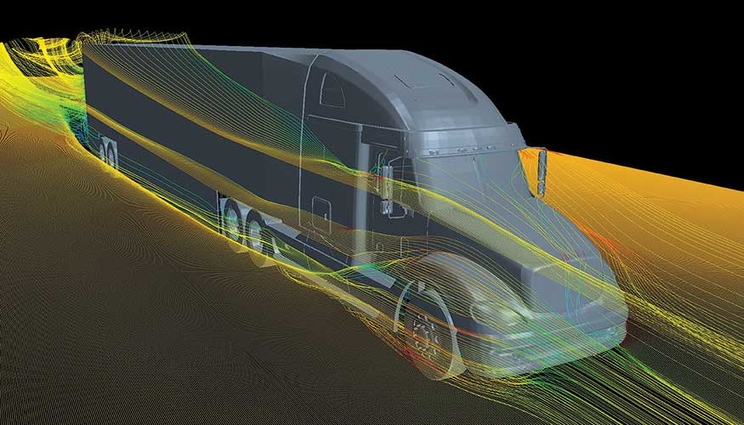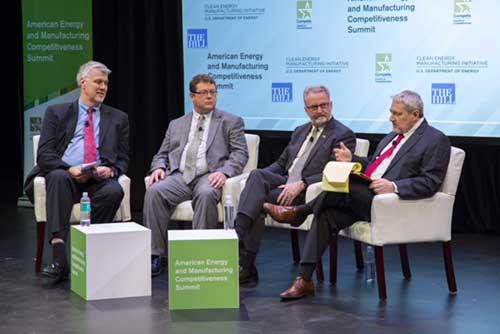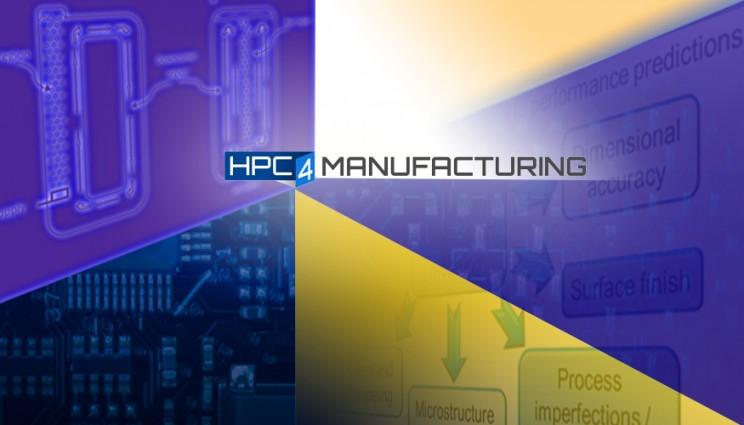Program puts HPC in hands of manufacturers
 (Download Image)
This computer simulation of aerodynamic drag on a tractor trailer was conducted as part of a DOE study to reduce the fuel consumption of trucks. A new initiative will allow industry to leverage the high performance computing capabilities of the national labs to advance clean energy manufacturing technologies.
(Download Image)
This computer simulation of aerodynamic drag on a tractor trailer was conducted as part of a DOE study to reduce the fuel consumption of trucks. A new initiative will allow industry to leverage the high performance computing capabilities of the national labs to advance clean energy manufacturing technologies.
A new Department of Energy (DOE) initiative will allow industry to leverage the high performance computing (HPC) capabilities of Lawrence Livermore (LLNL), Oak Ridge and Lawrence Berkeley national laboratories to advance clean energy manufacturing technologies. The new program was announced by David Danielson, assistant secretary for Energy Efficiency and Renewable Energy (EERE), Tuesday, at DOE’s third annual American Energy and Manufacturing Competitiveness summit in Washington D.C.
The High Performance Computing for Manufacturing Program (HPC4Mfg) will make up to $5 million available to national laboratories to work with qualified industry partners. HPC4Mfg will couple U.S. manufacturers with the national laboratories' world-class computational research and development expertise to address key challenges in U.S. manufacturing.
"With the HPC for Manufacturing program, DOE is taking the lead in recognizing the untapped resources and potential economic impact that the national laboratories represent. HPC4Mfg is designed to lower the cost of entry and to ease the way for U.S. manufacturers to use high performance modeling and simulation for a competitive edge," said LLNL Director Bill Goldstein, who was a panelist at the summit. "Specifically, we’ll have the opportunity to explore challenges in the most energy-intensive products and processes where modeling and simulation are ideally suited to offer solutions."
Under the program, selected projects will apply modeling, simulation and data analysis to industrial products and processes to lower production costs and shorten the time to market for new clean energy technologies. The goal is to keep the United States at the forefront of innovation by accelerating advanced clean energy technology and energy efficiency techniques.
HPC4Mfg adds a new dimension to DOE’s EERE Clean Energy Manufacturing Initiative (CEMI), sponsor of the annual summit along with the Council on Competitiveness. CEMI aims to increase American competitiveness in the production of clean energy products and to boost U.S. manufacturing competitiveness across the board by increasing energy productivity.
Lawrence Livermore will lead the HPC4Mfg program. The $5 million will be used to initially fund eight to 10 projects to be selected through a review committee, with representatives from DOE and the three national labs. Projects also may include nonprofit partners. Initial funding will be for up to one year. These will build on the foundation of five currently approved seedling projects.
Under one such collaboration, LLNL is working with Purdue University Calumet to develop an integrated HPC modeling simulation and visualization capability for steel manufacturing called "The Virtual Blast Furnace." Lawrence Berkeley and LLNL are working with The Agenda 2020 Technology Alliance to develop a high-fidelity model for coupling flow and mechanical deformation of the re-wet of the porous paper web during the manufacturing process, which would improve the drying of paper products.
Other projects include working with: Carbontec Energy Corp. to use HPC to model the E-iron nugget process – a new way of steelmaking using biofuel; SORAA to develop a high quality crystal growth model for the gallium nitride (GaN) reactor (to accelerate development of the reactor); and Gas Technology Institute to use computational modeling to advance combined heat and power system development.
"We will match industry proposals with the expertise and HPC resources resident at the three national labs," said Peg Folta, LLNL director of HPC4Mfg. "Our goal is to accelerate innovation, reduce the time to bring clean energy technologies to market and introduce efficiencies to energy manufacturing processes."
Computer scientists at the national labs benefit by expanding codes and applying them to a different problem set. The skills and new applications they develop can then be applied to DOE missions in such areas as energy, materials science and national security.
At Lawrence Livermore, the High Performance Computing Innovation Center (HPCIC) helps foster collaborations with industry by providing U.S. companies access to LLNL’s HPC ecosystem — including a range of large-scale computing clusters and architectures, validated application software and scientific and engineering domain expertise.
Contact
Don Johnston[email protected]
925-423-4902
Related Links
High Performance Computing for Manufacturing ProgramClean Energy Manufacturing Initiative
HPC Innovation Center
Tags
HPC, Simulation, and Data ScienceComputing
HPC Innovation Center
Featured Articles









